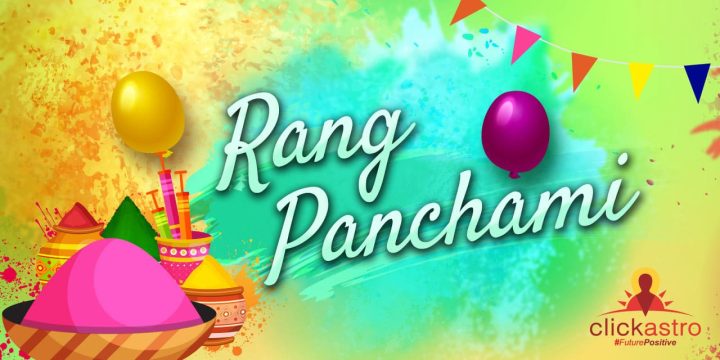Rang Panchami is a lesser-known yet deeply significant festival that follows the grand
celebrations of Holi. Marking the fifth day after
Holika Dahan, it carries forward the spirit of colours and festivity but with a deeper spiritual meaning. The festival is observed with enthusiasm in Maharashtra, Madhya Pradesh, and several northern states of India.
In 2025, Rang Panchami falls on Wednesday, March 19, bringing a wave of joy, devotion, and vibrant hues.
The Significance of Rang Panchami
Rang Panchami is rooted in Hindu traditions and the philosophy of cleansing negative energies. Holika Dahan, which precedes Holi, symbolizes the destruction of impurities, represented by the burning of pyres. The smoke released is believed to rid the environment of rajas (aggression) and tamas (lethargy). Five days later, on Rang Panchami, the air is considered purified, making it the ideal time for invoking divine energies through colours. The festival represents harmony between human existence and the natural elements, with the joyous application of colours serving as a tribute to this balance.
How Rang Panchami Differs from Holi
Although Rang Panchami and Holi may appear similar, their purposes differ. Holi is widely celebrated as a festival of colours, marking the victory of good over evil. It is an independent festival with cultural and mythological significance, observed with bonfires, feasts, and riotous celebrations.
Rang Panchami, on the other hand, is seen as a continuation of Holi’s legacy. The five-day gap signifies the culmination of purification, and the celebration is focused on invoking deities through colours. While Holi has a more social and cultural essence, Rang Panchami has spiritual connotations. In several regions, including Maharashtra, the grand Holi festivities extend to Rang Panchami, with vibrant street processions and community revelry.
Regional Celebrations and Unique Traditions
The way Rang Panchami is celebrated varies across different states. In Indore, Madhya Pradesh, the event is marked by an exhilarating procession where a water tanker fitted with high-pressure water cannons drenches the masses in a flood of coloured water. Thousands gather on the streets to participate in this unique spectacle, making it a major highlight of the city’s cultural calendar.
In Maharashtra, the festival holds special significance among the Koli community, the traditional fisherfolk of the state. Their celebrations are filled with music, dance, and the application of colours. Devotees visit temples to seek blessings and participate in community events that promote togetherness.
Temples in Vrindavan and Mathura, the land of Lord Krishna, witness grand rituals and joyous gatherings on this day. The connection with Krishna, who is known for his love of colours and playful spirit, makes Rang Panchami an essential part of the cultural traditions in these temple towns. In Delhi, Bihar, and Uttar Pradesh, temples hold special pujas, and devotees engage in symbolic acts of colour application, signifying devotion and divine blessings.
The Hidden Dangers of Synthetic Colours
The excitement of Rang Panchami often leads to the rampant use of synthetic colours, many of which contain harmful chemicals. Bright hues such as red, black, green, and silver are often laced with toxic substances, heavy metals, and even crushed glass particles. These artificial colours can cause skin allergies, eye infections, and long-term health risks such as respiratory issues.
Skin-related conditions, including rashes, dryness, and eczema, have been increasingly reported post-Holi and Rang Panchami. In extreme cases, prolonged exposure to chemical-laden colours has been linked to serious ailments. As awareness grows, many people are now switching to organic and natural colours derived from flowers, turmeric, sandalwood, and herbal extracts. These alternatives are not only safer for human health but also environmentally friendly, preventing toxic runoff into water bodies and soil.
How to Celebrate an Eco-Friendly Rang Panchami
With growing environmental concerns, more people are turning to sustainable ways of celebrating Rang Panchami. Dry herbal colours are recommended over water-based ones, as many regions face water shortages. Organic colours, made from beetroot, henna, turmeric, and dried flowers, provide vibrant shades without causing harm to the skin or the environment.
To prepare for a safe celebration, applying coconut oil or mustard oil to the skin and hair can prevent colours from sticking. Wearing protective sunglasses shields the eyes from accidental exposure, and post-celebration, gentle cleansing with natural remedies such as curd, lemon juice, and aloe vera can help remove residual colours effectively. By making these conscious choices, the festival can remain an occasion of joy without harming personal health or nature.
Colours and Their Deeper Meaning
Colours are deeply symbolic in Vedic traditions. Each planet in Hindu astrology is associated with a particular colour and energy. For example, the Sun is linked to shades of orange and red, Mercury to green, Jupiter to yellow, and Venus to white with hints of indigo. Even deities are represented by distinct colours, with Lord Krishna often depicted in shades of blue, symbolizing vastness and divinity.
Psychologically, colours have a profound impact on human emotions. Warm colours such as red and orange are known to stimulate energy and passion, while cool colours like blue and green bring calmness and serenity. This connection between colour and human psychology makes festivals like Rang Panchami a crucial celebration of vibrancy and positivity.
The Deeper Spiritual Essence of Panchami Tithi
Panchami, the fifth day in the
lunar calendar, holds significant spiritual importance. It is governed by
Guru (Jupiter) and represents knowledge, growth, and auspiciousness. The deity associated with Panchami is Vahni Vasini, symbolizing the creative fire and the drive for progress. Many
Hindu festivals, including
Basant Panchami and
Nag Panchami, are celebrated on this tithi, each carrying unique meanings and rituals.
On Rang Panchami, this spiritual energy is at its peak, making it an ideal time for reflection, renewal, and embracing the joy of colours. The festival stands as a reminder of the importance of purity, not just in the environment but within oneself. By shedding negative energies and embracing positivity, individuals can invite prosperity, happiness, and divine blessings into their lives.
Embracing the Spirit of Rang Panchami 2025
As Rang Panchami approaches in 2025, it is an opportunity to embrace tradition while being mindful of health and environmental impact. The festival’s essence goes beyond the application of colours—it is about renewal, positivity, and celebrating the divine forces that surround us. Whether participating in grand street festivities or enjoying a simple celebration with loved ones, Rang Panchami serves as a beautiful reminder that colours have the power to uplift, heal, and bring communities together. By choosing safe and sustainable ways to celebrate, we ensure that the festival continues to spread joy for generations to come.

